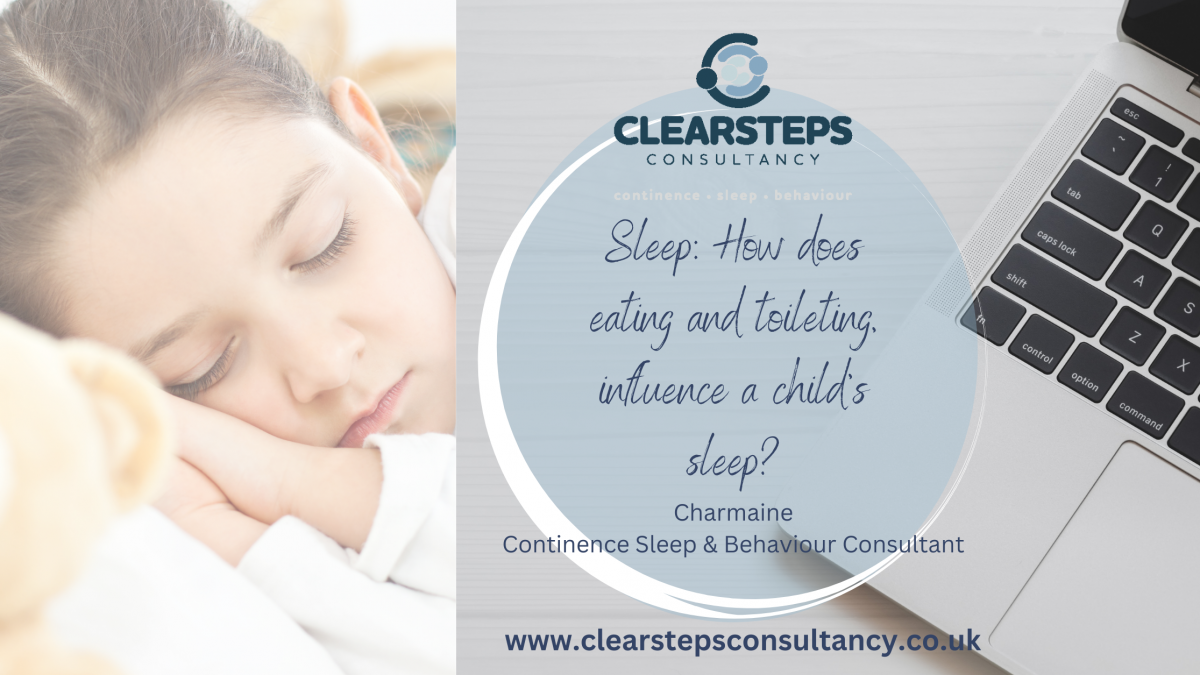Sleep: How does eating and toileting influence a child's sleep?

Sleep can be influenced by eating and toileting, but how? Within this blog post we share how and where to start in helping your child progress.
Sleep difficulties, or struggling to settle to sleep or waking in the night or waking early in the morning, can have more of an impact, than a child just being tired. Children can experience:
- Tiredness
- Increased appetite
- Inability to concentrate
- Mood swings
- Poor balance and coordination
- And more.
Our childrens ability to sleep, is governed by a twenty-four hour internal clock, called the circadian rhythm. The circadian rhythm is all about eating drinking, toileting, exercising and sleeping at regular times each day to prepare the body for sleep.
The circadian rhythm works with a natural hormone, called melatonin, which regulates the bodies temperature, blood pressure and hormone levels. The hormone, melatonin levels rise in the body, when it is dark outside, signally that sleep needs to take place.
How does eating and toileting, influence a child's sleep?
A child's ability to sleep is directly connected to the activities which take place in the day, including toileting and eating.
For a child to be able to settle to sleep, one of the areas to focus on is weeing and pooing regularly in the daytime. To pass wees and poos regularly within the daytime a child needs to first, learn to recognise the internal signals of needing to use the toilet.
A child can be supported in recognising the internal signal of needing to use the toilet, through regulating eating and drinking.
Eating at set times of the day, enables a child's wees and poos to be passed regularly. The day time activity of eating at set times and weeing and pooing at set times, toileting in the day time, helps the body to prepare for sleep, through helping the circadian rhythm.
When a child is not eating a set times, wees and poos are not able to be passed at set times. When wees and poos are not being passed at set times, a wee difficulty such as bedwetting can occur and / or a poo difficulty such as constipation can occur.
Constipation is when Type 1, 2 or 3 poo, according to the Bristol Stool Chart are passed, less than three times a week, or when any type of large poo are passed. The longer a poo remains within the body, the dryer and harder it becomes.
There are several reasons why a child may wake in the night, resulting in a disturbed or unsettled sleep. Two of the reasons are:
- Dryer, harder poos moving within the large bowel, causing discomfort: constipation
- Wetting occurring at night: bedwetting
655f9ed02fcab_lg.png)
Where to start in helping a child, progress with sleep?
When considering the influence of eating, food, toileting and a child's ability to sleep, it is also important to consider "what" our children are eating, their patterns and toilet routines.
We can start by helping with the following:
- Identify what your child's current patterns are. Are they eating at set times, weeing and pooing at set times, drinking at set times or sleeping at set times. To confirm your child's daily patterns complete the FREE Gut Health Tracker. Click here to download your copy today: FREE Gut Health Tracker
- Introduce sleep inducing foods to promote sleep. Tryptophan is an amino acid that has the ability to increase the onset of sleep, decrease the spontaneous waking's and increase the overall length of sleep that a child experiences. Foods rich in Tryptophan, include: bananas, turkey, dairy, cabbage, kidney beans, oats, poppy seeds, spinach, wheat, soya beans, eggs, red meat, poultry, tofu and more. It is recommended to choose one or two foods from the list, that you feel your child will tolerate and / or enjoy.
- Introduce a routine of eating i.e. a routine of eating breakfast, snack, lunch, snack and an evening meal each day, at set times.
- If your child is struggling to eat at set times, there are many reason for this occurring. For further information and support with eating, feel free to view the FREE fact sheet: Where to start with eating? and view our FREE Blog post: Won`t or Can`t eat
- Rule out any underlying physical health care or medical needs that may be affecting your child's sleep. Do you know your child's poo type? or poo pattern? Poo can impact upon our childrens sleep routine. Read more about poo and how to help your child within our FREE blog post: Do you know your child poo type?

How can Clear Steps Consultancy help with Sleep?
Charmaine, at Clear Steps Consultancy supports children with and without a diagnosis, additional needs, their families, schools, organisations, charities and professionals in progressing and being successful with Toileting, Sleeping and Understanding Behaviour. Support available to help with Sleep, is as individual as the children, families and schools themselves, from online support to one to one Parenting Support Packages to Comprehensive assessments.
Charmaine, helps children and their families progress with sleep, through a step by step approach. The pathway of support confirms the next steps
66f3e20146b88_lg.png)
Help and support is available!
Start helping your child, in progressing with sleep today!

Scan this QR code to start your child's Sleep Journey.
What next: | ||
| Click onto the QR code and start your child's sleep journey.
Sign up to the Clear Steps: Monthly News Letter To, Keep up to date with the latest events, online courses, LIVE sessions, FREE downloads and new support options available to help you and your family click here: Newsletter. For further support and advice and book your FREE Introductory Consultation Call, LIVE support sessions, online courses or one to one approaches. |
Categories: : eating, Poo, sensory needs and eating, Sensory needs and toileting, sleep, Toileting
Sleep eating and toileting connections Charmaine Champ
Charmaine Champ 